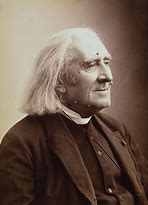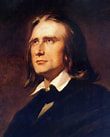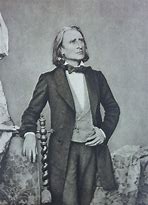Franz Liszt



This about LISZT: 1811, he was born not far from the Esterhazy estate where his father worked with Haydn. 1813, he learned the piano from his father as soon as he could sit. 1820, he gave his first concert at the Esterhazy court. 1821, he went with his father to Vienna to study with Salieri (Mozart’s peer, Beethoven’s contemporary, Schubert’s teacher), and Czerny (Beethoven’s greatest pupil). 1822, he met Beethoven, met Schubert. 1823, he toured Munich, Stuttgart, and Strasbourg. 1824, he played London, for George IV at Carlton House. 1827, he lost his father, retired from concerts, gave lessons in Paris, introspection turning to depression when he was surprised one midnight in the arms of his first love (the daughter of a nobleman to whom he gave piano lessons) and turned from the house like a servant stealing silver—not for the seduction, but the presumption (seduction was welcome, but not from a music teacher).
Three influences were to set his style: hearing Berlioz, he wanted to expand the palette of his piano to that of the orchestra; hearing Paganini, he wanted to drive his listeners to the same paroxysms of frenzy; hearing Chopin, he wanted to develop feathers in his fingers as he had already developed hammers. Playing into the night at a small party at Chopin’s, for Heine, Delacroix, Rossini, Meyerbeer, and George Sand, he met Marie d’Agoult, six years older, who abandoned her husband and two daughters to become the mother of his children, the three he acknowledged, and provide the final polish to his persona, the touch of the aristocrat. Such was the pedigree of this prodigy.